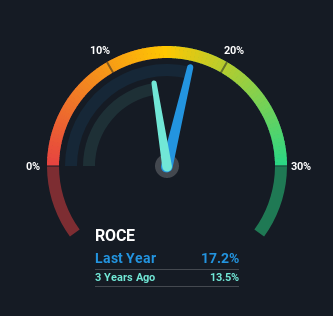If we want to find a stock that could multiply over the long term, what are the underlying trends we should look for? Firstly, we'd want to identify a growing return on capital employed (ROCE) and then alongside that, an ever-increasing base of capital employed. If you see this, it typically means it's a company with a great business model and plenty of profitable reinvestment opportunities. So, when we ran our eye over SIS' (NSE:SIS) trend of ROCE, we liked what we saw.
Return On Capital Employed (ROCE): What is it?
For those who don't know, ROCE is a measure of a company's yearly pre-tax profit (its return), relative to the capital employed in the business. Analysts use this formula to calculate it for SIS:
Return on Capital Employed = Earnings Before Interest and Tax (EBIT) ÷ (Total Assets - Current Liabilities)
0.17 = ₹4.1b ÷ (₹48b - ₹25b) (Based on the trailing twelve months to September 2021).
Thus, SIS has an ROCE of 17%. On its own, that's a standard return, however it's much better than the 8.1% generated by the Commercial Services industry.
View our latest analysis for SIS

In the above chart we have measured SIS' prior ROCE against its prior performance, but the future is arguably more important. If you'd like to see what analysts are forecasting going forward, you should check out our free report for SIS.
What The Trend Of ROCE Can Tell Us
While the returns on capital are good, they haven't moved much. The company has consistently earned 17% for the last five years, and the capital employed within the business has risen 162% in that time. Since 17% is a moderate ROCE though, it's good to see a business can continue to reinvest at these decent rates of return. Stable returns in this ballpark can be unexciting, but if they can be maintained over the long run, they often provide nice rewards to shareholders.
Another thing to note, SIS has a high ratio of current liabilities to total assets of 51%. This can bring about some risks because the company is basically operating with a rather large reliance on its suppliers or other sorts of short-term creditors. Ideally we'd like to see this reduce as that would mean fewer obligations bearing risks.
The Key Takeaway
The main thing to remember is that SIS has proven its ability to continually reinvest at respectable rates of return. However, over the last three years, the stock has only delivered a 17% return to shareholders who held over that period. So to determine if SIS is a multi-bagger going forward, we'd suggest digging deeper into the company's other fundamentals.
If you want to continue researching SIS, you might be interested to know about the 1 warning sign that our analysis has discovered.
While SIS isn't earning the highest return, check out this free list of companies that are earning high returns on equity with solid balance sheets.
New: Manage All Your Stock Portfolios in One Place
We've created the ultimate portfolio companion for stock investors, and it's free.
• Connect an unlimited number of Portfolios and see your total in one currency
• Be alerted to new Warning Signs or Risks via email or mobile
• Track the Fair Value of your stocks
Have feedback on this article? Concerned about the content? Get in touch with us directly. Alternatively, email editorial-team (at) simplywallst.com.
This article by Simply Wall St is general in nature. We provide commentary based on historical data and analyst forecasts only using an unbiased methodology and our articles are not intended to be financial advice. It does not constitute a recommendation to buy or sell any stock, and does not take account of your objectives, or your financial situation. We aim to bring you long-term focused analysis driven by fundamental data. Note that our analysis may not factor in the latest price-sensitive company announcements or qualitative material. Simply Wall St has no position in any stocks mentioned.
About NSEI:SIS
SIS
Provides security and related services in India, Australia, Singapore, and New Zealand.
Flawless balance sheet with moderate growth potential.
Market Insights
Community Narratives





